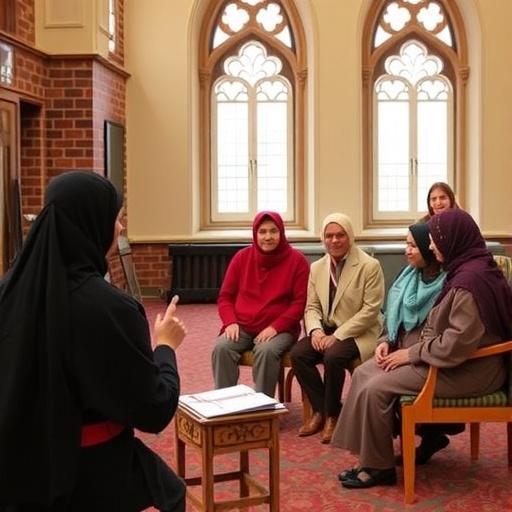A new era of interfaith learning in higher education has dawned, as universities across the UK embarks on initiatives designed to foster dialogue, understanding, and collaboration among students from diverse faith backgrounds. A recent longitudinal survey conducted by prominent researchers, including Aune, Peacock, and Rockenbach, delves into the complexities of interfaith engagement, offering invaluable insights on how institutions of higher learning can actively support this crucial social discourse. This effort aims not only to enhance intercultural competencies but also to address pressing global issues rooted in religious misunderstanding and conflict.
Interfaith learning is not merely an academic pursuit; it represents a fundamental societal need. As the world becomes more interconnected, the importance of understanding different faith perspectives cannot be overstated. Universities serve as a microcosm of society, where students from various backgrounds come together, often for the first time. This unique environment presents an unprecedented opportunity for interfaith exploration, but it also poses challenges as differing beliefs can sometimes lead to friction rather than collaboration.
The researchers’ longitudinal survey seeks to measure how effectively universities can cultivate environments where interfaith dialogue thrives. Their findings reveal that many universities have already implemented programs aimed at fostering inclusivity but often lack the systematic approach necessary for long-term success. This inconsistency raises vital questions about what steps can be taken to create a more supportive climate for interfaith dialogue.
One of the significant revelations from the survey is the power dynamics at play within campus communities. Students from minority faith groups often report feeling isolated or marginalized, leading to a lack of engagement in interfaith initiatives. This sense of alienation underscores the urgency for universities to employ strategies that actively engage all students and encourage participation from underrepresented faith perspectives. Without concerted efforts to address these challenges, the goal of genuine interfaith dialogue risks becoming just another superficial initiative rather than a transformative educational experience.
Moreover, the study highlights the recognition of interfaith learning as an educational outcome rather than an ancillary aspect of university life. As educational frameworks evolve, it becomes essential for institutions to integrate interfaith competencies into their curricula actively. This could involve developing courses centered around religious literacy and experiential learning opportunities where students engage directly with diverse faith communities. By embedding interfaith learning into the academic structure, universities can cultivate a deeper understanding and respect for different beliefs among future leaders.
However, establishing a framework for effective interfaith education does not come without its hurdles. Resistance can stem from various quarters, particularly from individuals who may see interfaith programs as diluting their beliefs or who misunderstand the purpose of such dialogues. Therefore, it is pivotal for university administrators and faculty to articulate the objectives and benefits of interfaith learning clearly, showing its relevance to personal development, social responsibility, and cultural competency.
The study also emphasizes the role of student organizations and peer-led initiatives in fostering interfaith engagement. Student groups have demonstrated their capacity to create safe spaces for dialogue, promoting collaboration among different faiths. Researchers found that when students take the lead on interfaith initiatives, the resulting programs tend to resonate more with their peers. These peer interactions create informal learning opportunities that can enhance the overall interfaith experience on campus.
In light of these findings, universities must recognize that supporting interfaith learning extends beyond organizational structures; it necessitates cultivating an atmosphere of empathy and understanding. Faculty and administrators should be trained in intercultural competencies and encouraged to model inclusive behaviors. This modeling can significantly influence students, as they often take cues from their mentors. In addition to providing resources for learning, the university community must engage in continuous reflection on its values and practices, ensuring a commitment to inclusivity.
The longitudinal nature of the survey indicates the necessity for ongoing assessment and adaptation of interfaith programs. Just as the demographics of the student body evolve, so too should the approaches to interfaith education. Regular feedback from students is essential in shaping these initiatives, helping educational leaders to identify effective practices and areas for improvement. This cycle of reflection and adaptation will ultimately lead to a more robust framework for interfaith learning that meets the needs of a diverse and changing student population.
Furthermore, the role of technology in facilitating interfaith learning cannot be overlooked. In today’s digital age, online platforms can provide invaluable resources for interfaith dialogue and education. Virtual discussions, webinars, and social media campaigns are among the myriad tools that universities can utilize to foster interfaith communication. These digital avenues can engage students beyond the confines of physical classrooms and extend learning opportunities to a global audience.
The implications of effective interfaith education extend into broader societal contexts. The skills and understanding gained through interfaith dialogues equip students to navigate an increasingly polarized world. As prospective leaders, these individuals must possess the tools to engage constructively with differing beliefs, facilitating peace and understanding in their future workplaces and communities. Thus, the potential impact of interfaith learning reaches far beyond the university setting, contributing to a more harmonious global society.
In conclusion, the survey spearheaded by Aune, Peacock, and Rockenbach sheds light on the vital role of universities in supporting interfaith learning. By taking a proactive and inclusive approach to this educational endeavor, institutions can enhance student experiences, promote greater understanding, and ultimately prepare a new generation equipped to engage with our world’s complexities. Interfaith learning, therefore, is not merely an academic goal but an essential pillar in shaping compassionate and informed global citizens.
Subject of Research: Interfaith Learning in Higher Education
Article Title: Correction to: How can universities support students’ interfaith learning? findings from a longitudinal survey of students in the UK.
Article References: Aune, K., Peacock, L., Rockenbach, A.N. et al. Correction to: How can universities support students’ interfaith learning? findings from a longitudinal survey of students in the UK. High Educ (2025). https://doi.org/10.1007/s10734-025-01575-0
Image Credits: AI Generated
DOI:
Keywords: Interfaith Learning, Higher Education, Student Engagement, Religious Diversity, Global Society, Educational Frameworks, Cultural Competency




